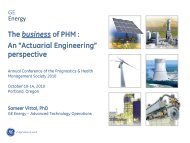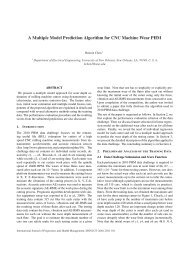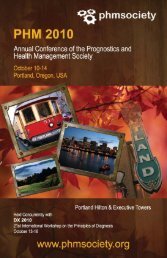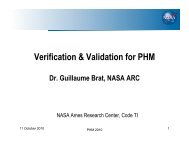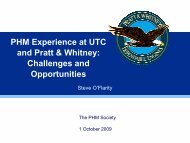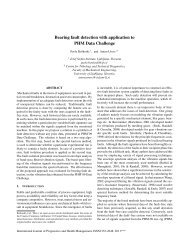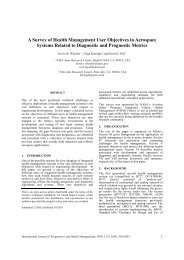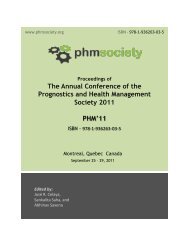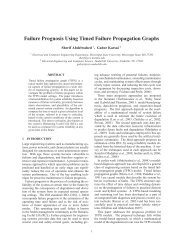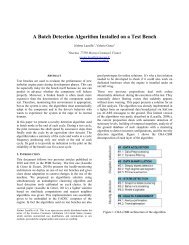Prediction of Fatigue Crack Growth in Airframe ... - PHM Society
Prediction of Fatigue Crack Growth in Airframe ... - PHM Society
Prediction of Fatigue Crack Growth in Airframe ... - PHM Society
Create successful ePaper yourself
Turn your PDF publications into a flip-book with our unique Google optimized e-Paper software.
<strong>Prediction</strong> <strong>of</strong> <strong>Fatigue</strong> <strong>Crack</strong> <strong>Growth</strong> <strong>in</strong> <strong>Airframe</strong> Structures<br />
J<strong>in</strong>dřich F<strong>in</strong>da 1 , Andrew Vechart 2 and Radek Hédl 3<br />
1,3 Honeywell International s.r.o., Brno, Tuřanka 100, 627 00, Czech Republic<br />
J<strong>in</strong>drich.F<strong>in</strong>da@Honeywell.com<br />
Radek.Hedl@Honeywell.com<br />
2 Honeywell International Inc., 1985 Douglas Drive North (M/S MN10-112B), Golden Valley, MN 55422, USA<br />
Andrew.Vechart@Honeywell.com<br />
ABSTRACT<br />
The paper describes the general proposal, function and<br />
performance <strong>of</strong> a prognostics system for fatigue crack<br />
growth <strong>in</strong> airframe structures. Prognostic capabilities are<br />
important to a superior Structural Health Monitor<strong>in</strong>g System<br />
(SHM). An aim <strong>of</strong> the prognosis is estimation / prediction <strong>of</strong><br />
a system / subsystem / structure rema<strong>in</strong><strong>in</strong>g life, i.e. the time<br />
at which damage (crack, corrosion, wear, delam<strong>in</strong>ation,<br />
disbond<strong>in</strong>g, etc.) will result <strong>in</strong> a failure <strong>of</strong> the considered<br />
element.<br />
1. INTRODUCTION<br />
<strong>Fatigue</strong> damage and its consequences are the most serious<br />
structural design and ma<strong>in</strong>tenance issues that have to be<br />
addressed. Several philosophies <strong>of</strong> how to decrease<br />
consequences <strong>of</strong> a fatigue hazard have been developed and<br />
applied. Serious aircraft accidents due to fatigue have<br />
contributed to this development and have started research<br />
efforts <strong>in</strong> this area. Two ma<strong>in</strong> philosophies for aircraft<br />
structure design are used nowadays:<br />
Safe Life - an extremely low level <strong>of</strong> risk is accepted<br />
through a comb<strong>in</strong>ation <strong>of</strong> test<strong>in</strong>g and analysis that the part<br />
will ever form a detectable crack due to fatigue dur<strong>in</strong>g the<br />
service life <strong>of</strong> the structure.<br />
Damage Tolerance - structure has the ability to susta<strong>in</strong><br />
defects safely until the defect is detected and repaired.<br />
Structural Health Monitor<strong>in</strong>g (SHM) - represents the next<br />
advanced step <strong>in</strong> structural damage monitor<strong>in</strong>g and<br />
ma<strong>in</strong>tenance plann<strong>in</strong>g. An occurrence <strong>of</strong> structural damage<br />
is monitored by a sophisticated automated system. Its usage<br />
does not demand additional time from <strong>in</strong>spections and<br />
qualified personal. A significant part <strong>of</strong> a SHM system and<br />
_____________________<br />
J<strong>in</strong>dřich F<strong>in</strong>da et al. This is an open-access article distributed under the<br />
terms <strong>of</strong> the Creative Commons Attribution 3.0 United States License,<br />
which permits unrestricted use, distribution, and reproduction <strong>in</strong> any<br />
medium, provided the orig<strong>in</strong>al author and source are credited.<br />
its application <strong>in</strong> aerospace is prognostics. It shifts a<br />
structural ma<strong>in</strong>tenance program to an advanced level and<br />
br<strong>in</strong>gs significant benefits for an aircraft operator like<br />
efficient ma<strong>in</strong>tenance plann<strong>in</strong>g, effective aircraft usage,<br />
service cost decrease, safety <strong>in</strong>crease, etc. Its application<br />
opens a new approach to aircraft design and br<strong>in</strong>gs a new<br />
advanced philosophy <strong>of</strong> structural lifetime estimation.<br />
2. ENTIS PROJECT DESCRIPTION<br />
This paper describes our approach to fatigue damage<br />
prognostics development. It is based on results from the<br />
ENTIS project supported by the M<strong>in</strong>istry <strong>of</strong> Industry and<br />
Trade <strong>of</strong> the Czech Republic. The ma<strong>in</strong> goal <strong>of</strong> this project<br />
is SHM system development, particularly its real application<br />
form, capabilities, conditions and issues def<strong>in</strong>ition.<br />
Experimental test<strong>in</strong>g is a basic part <strong>of</strong> this project. <strong>Fatigue</strong><br />
tests <strong>of</strong> aircraft structure parts have been done and structural<br />
damage has been monitored by an ultrasonic method. All<br />
structural specimens are parts <strong>of</strong> an L-410 UVP-E airplane<br />
(Figure 1), which is an all-metal high-w<strong>in</strong>g monoplane<br />
powered by two turboprop eng<strong>in</strong>es. The airplane is certified<br />
<strong>in</strong> the commuter category <strong>in</strong> accordance with (FAR) PART<br />
23 requirements. All structural specimens are considered<br />
critical parts <strong>of</strong> the aircraft structure <strong>in</strong> the sense <strong>of</strong> fatigue<br />
damage. The fatigue test arrangement is shown <strong>in</strong> Figure 2.<br />
Figure 1. Aircraft Industries a. s. L-410 UVP-E airplane
European Conference <strong>of</strong> Prognostics and Health Management <strong>Society</strong> 2012<br />
Figure 2. W<strong>in</strong>g Spar <strong>Fatigue</strong> Test<br />
For the purpose <strong>of</strong> generation and registration <strong>of</strong> ultrasonic<br />
waves shear plate PZT actuators were used (Figure 3).<br />
Characteristics <strong>of</strong> the particular PZT actuators from Noliac<br />
used are shown <strong>in</strong> (Table 1). The actuators are characterized<br />
by their small dimensions, low weight, and low cost. This<br />
allows <strong>in</strong>stallation <strong>of</strong> large and non-expensive sensor arrays<br />
on an airframe with very small impact on the structure<br />
performance and aerodynamic properties. Moreover, the<br />
small dimensions <strong>of</strong> the PZT elements are suitable for<br />
<strong>in</strong>tegration <strong>of</strong> the sensor array on a flexible strip, which<br />
significantly accelerates the process <strong>of</strong> sensor array<br />
<strong>in</strong>stallation on the monitored structure.<br />
PZT Sensors<br />
Figure 3. W<strong>in</strong>g Spar <strong>Fatigue</strong> Test<br />
Figure 4. Block scheme <strong>of</strong> the crack growth monitor<strong>in</strong>g<br />
system<br />
The block scheme <strong>of</strong> the advanced signal process<strong>in</strong>g for the<br />
automated monitor<strong>in</strong>g <strong>of</strong> fatigue damage <strong>of</strong> the particular<br />
aircraft structural part is <strong>in</strong> Figure 4. A sparse sensor array<br />
enclos<strong>in</strong>g the monitored area (Hot Spot) is used for<br />
collection <strong>of</strong> the data used for evaluation <strong>of</strong> the actual state<br />
<strong>of</strong> the structure. Therefore, the automated defect detection /<br />
siz<strong>in</strong>g is based on evaluation <strong>of</strong> changes <strong>in</strong> direct signal<br />
paths, i.e. signals between <strong>in</strong>dividual pairs <strong>of</strong> PZT actuators<br />
where one PZT actuator works as source <strong>of</strong> the ultrasonic<br />
wave and the second one as sensor. First, Signal Difference<br />
Coefficients (SDCs) for <strong>in</strong>dividual paths are calculated<br />
evaluat<strong>in</strong>g differences between basel<strong>in</strong>e and actual signals<br />
measured on the monitored structure. These SDCs represent<br />
a Damage Index (DI), which gives <strong>in</strong>formation on the extent<br />
<strong>of</strong> the structure damage. The defect occurrence is <strong>in</strong>dicated<br />
and defect size is estimated us<strong>in</strong>g an Artificial Neural<br />
Network, which transforms a feature vector captur<strong>in</strong>g<br />
significant features (DIs) <strong>of</strong> an identified defect to<br />
demanded parameters (defect occurrence, defect size),<br />
which are used as <strong>in</strong>puts <strong>of</strong> prognostics algorithm.<br />
Type<br />
Length<br />
[mm]<br />
Width<br />
[mm]<br />
Height<br />
[mm]<br />
Maximum<br />
voltage<br />
[V]<br />
Free<br />
stroke<br />
[µm]<br />
Capacitance<br />
[pF]<br />
CSAP02 5 5 0.5 +/-320 1.5 830<br />
Table 1. PZT Actuator Parameters<br />
2
European Conference <strong>of</strong> Prognostics and Health Management <strong>Society</strong> 2012<br />
3. FATIGUE CRACK GROWTH PROGNOSTICS<br />
The fatigue crack growth prognosis is used for RUL<br />
prediction. The RUL is def<strong>in</strong>ed by the crack length reach<strong>in</strong>g<br />
its critical size limit. The concept <strong>of</strong> the crack growth<br />
prognostic algorithm is shown <strong>in</strong> (Figure 4). Input <strong>of</strong> the<br />
prognostic algorithm consists <strong>of</strong> the crack length observed<br />
dur<strong>in</strong>g a particular <strong>in</strong>spection, i.e. measured by the SHM<br />
system, and the typical load<strong>in</strong>g sequence. Several<br />
algorithms for the crack growth calculation can be found <strong>in</strong><br />
literature (Beden & Abdullah & Ariff<strong>in</strong>, 2009). Those<br />
algorithms are based on various approaches: fracture<br />
mechanics & empirical models (Beden & Abdullah &<br />
Ariff<strong>in</strong>, 2009), or data based models (Forman, R. G. &<br />
Shivakumar, V & Card<strong>in</strong>al J.W. & Wiliams, L.C. &<br />
McKeigham, P.C. 2005). Suitability <strong>of</strong> these approaches for<br />
a particular application depends on the actual type <strong>of</strong><br />
load<strong>in</strong>g, type <strong>of</strong> structure and other boundary conditions and<br />
available <strong>in</strong>puts for tun<strong>in</strong>g <strong>of</strong> the crack growth model.<br />
Our developed prognostic system uses the NASGRO<br />
equation as the crack growth model (NASGRO Reference<br />
Manual, version 4.2), August<strong>in</strong> (2009). This approach was<br />
selected for the follow<strong>in</strong>g reasons: (1) This equation is<br />
widely used <strong>in</strong> aerospace, (2) All <strong>in</strong>puts required for the<br />
crack growth model related to duralum<strong>in</strong> aircraft structure<br />
are available <strong>in</strong> literature, (3) Influence <strong>of</strong> variable<br />
amplitude load<strong>in</strong>g is accounted for <strong>in</strong> the NASGRO model,<br />
(4) This algorithm solves the crack growth <strong>in</strong> all three<br />
phases <strong>of</strong> the crack propagation (crack <strong>in</strong>itiation, stable<br />
crack growth, unstable crack growth).<br />
The SHM system is focused on the so called Pr<strong>in</strong>ciple<br />
Structure Element (PSE). PSE’s are those elements <strong>of</strong> a<br />
primary structure which contribute significantly to carry<strong>in</strong>g<br />
flight, ground, and pressurization loads, and whose failure<br />
could result <strong>in</strong> catastrophic failure <strong>of</strong> the airplane. Sensors<br />
are <strong>in</strong>stalled on hot-spots <strong>in</strong> order to provide <strong>in</strong>formation on<br />
the actual status <strong>of</strong> the structure <strong>in</strong>tegrity, (i.e. actual length<br />
<strong>of</strong> the fatigue crack). Each hot-spot is treated separately,<br />
(i.e. prognosis <strong>of</strong> the crack growth for particular hot-spot is<br />
done without account<strong>in</strong>g for the effect <strong>of</strong> presence <strong>of</strong> other<br />
cracks out <strong>of</strong> the hot-spot). However, each hot-spot may<br />
conta<strong>in</strong> multiple cracks.<br />
3.1. Input <strong>Crack</strong> Length<br />
The crack length observed dur<strong>in</strong>g a particular <strong>in</strong>spection is<br />
used as an <strong>in</strong>itial crack length for the prognostic algorithm.<br />
Evaluation <strong>of</strong> the crack length is done us<strong>in</strong>g a feature vector,<br />
which consists <strong>of</strong> DIs. The vector is applied on an <strong>in</strong>put <strong>of</strong><br />
an Artificial Neural Network as was described above. The<br />
prognostic algorithm propagates the <strong>in</strong>itial crack length <strong>in</strong>to<br />
the future us<strong>in</strong>g a typical load<strong>in</strong>g sequence. Thus, the<br />
prognosis is done for each <strong>in</strong>spection, i.e. for each crack<br />
length observed.<br />
3.2. Typical Load<strong>in</strong>g Sequence and Flight Load<strong>in</strong>g<br />
Spectrum<br />
The type <strong>of</strong> the w<strong>in</strong>g flange specimen load<strong>in</strong>g is the same as<br />
the real load<strong>in</strong>g on a real aircraft w<strong>in</strong>g flange. It is a<br />
comb<strong>in</strong>ation <strong>of</strong> a bend<strong>in</strong>g moment and an axis force.<br />
The load<strong>in</strong>g sequence represents a series <strong>of</strong> load<strong>in</strong>g cycles<br />
(Figure 5) affect<strong>in</strong>g the structure. Duration <strong>of</strong> a load<strong>in</strong>g<br />
cycle is constant for the whole sequence, i.e. 1/3s. Each<br />
cycle is described by its maximal and m<strong>in</strong>imal stress levels<br />
[σ m<strong>in</strong> , σ max ]. The maximal and m<strong>in</strong>imal stress levels are<br />
expressed as multiples <strong>of</strong> a nom<strong>in</strong>al stress σ 0 . Thus, we have<br />
a pair <strong>of</strong> numbers {n m<strong>in</strong> , n max } so called load factors for a<br />
s<strong>in</strong>gle load<strong>in</strong>g cycle.<br />
A typical flight spectrum for a particular aircraft (Figure 6)<br />
is used <strong>in</strong> order to def<strong>in</strong>e a typical flight load<strong>in</strong>g sequence.<br />
The typical flight spectrum was def<strong>in</strong>ed accord<strong>in</strong>g to FAA<br />
AC 23-13A. The total load<strong>in</strong>g spectrum dur<strong>in</strong>g the flight<br />
composes two load<strong>in</strong>g spectra: w<strong>in</strong>d gust and maneuvers.<br />
The load<strong>in</strong>g sequence can be derived from the typical flight<br />
spectrum <strong>in</strong> various ways. Most <strong>of</strong>ten the block load<strong>in</strong>g<br />
sequence or random load<strong>in</strong>g sequence is used:<br />
Block load<strong>in</strong>g sequence – load<strong>in</strong>g cycles <strong>of</strong> the same<br />
amplitude are organized <strong>in</strong> blocks, which consist <strong>of</strong> a<br />
number <strong>of</strong> load<strong>in</strong>g cycles.<br />
Random load<strong>in</strong>g sequence – load<strong>in</strong>g cycles, which have<br />
various amplitudes, are randomly organized <strong>in</strong> the load<strong>in</strong>g<br />
sequence (Figure 7).<br />
Figure 5. Typical Load<strong>in</strong>g Cycle<br />
3
European Conference <strong>of</strong> Prognostics and Health Management <strong>Society</strong> 2012<br />
(1)<br />
where C, f, ΔK th , K max , K c , p and q are model parameters<br />
given by the structure material and geometry.<br />
Figure 6. Typical Flight Spectrum for L-410 UVP-E<br />
Figure 7. Random Load<strong>in</strong>g Sequence for One Flight<br />
4. PROGNOSTIC ALGORITHM PERFORMANCE<br />
Two sets <strong>of</strong> experimental data from laboratory fatigue tests<br />
<strong>of</strong> w<strong>in</strong>g flanges (Figure 2) were used as <strong>in</strong>puts for the<br />
prognosis algorithm performance assessment. In both tests,<br />
a two-tip crack 2 x 1.27 mm long was <strong>in</strong>itiated at the rivet<br />
hole. One tip po<strong>in</strong>ted to edge <strong>of</strong> the flange – external crack,<br />
and the other one to the flange axis <strong>of</strong> symmetry - <strong>in</strong>ternal<br />
crack. The <strong>in</strong>tention <strong>of</strong> the experiment was to 1) evaluate<br />
performance <strong>of</strong> the crack measurement system and 2) obta<strong>in</strong><br />
fatigue crack growth data. Ideally the only two major cracks<br />
near the measurement site would have been those <strong>in</strong>itiated<br />
<strong>in</strong>tentionally. This was the case for the first set <strong>of</strong><br />
experimental data. However, dur<strong>in</strong>g the second experiment,<br />
several other cracks formed with<strong>in</strong> the test article,<br />
contam<strong>in</strong>at<strong>in</strong>g the experimental data. Nonetheless, the<br />
performance <strong>of</strong> the fatigue crack prognosis model is<br />
compared with both sets <strong>of</strong> experimental data.<br />
3.3. Stress Intensity Factor<br />
The calculation <strong>of</strong> the stress <strong>in</strong>tensity factor (SIF) at the<br />
crack tip for a nom<strong>in</strong>al load is based on a f<strong>in</strong>ite element<br />
analysis (FEA), which requires knowledge <strong>of</strong> the structure<br />
and crack geometry. The FEA provides stress energy release<br />
rates for the tip from where stress <strong>in</strong>tensity factor K σ0 (N)<br />
can be calculated. The FEA analysis is time consum<strong>in</strong>g and<br />
too complex to <strong>in</strong>clude <strong>in</strong> an onl<strong>in</strong>e system. Onl<strong>in</strong>e FEA<br />
calculation <strong>of</strong> the stress <strong>in</strong>tensity factor K σ0 (N) is replaced<br />
by a lookup table for our purpose.<br />
3.4. <strong>Crack</strong> <strong>Growth</strong> Equation<br />
Calculation <strong>of</strong> the crack <strong>in</strong>crement for a particular load<br />
cycle is done us<strong>in</strong>g the NASGRO equation <strong>of</strong> fracture<br />
mechanics Eq. (1).<br />
Figure 8. <strong>Fatigue</strong> <strong>Crack</strong> Prognosis with First Set <strong>of</strong><br />
Experimental Data<br />
4
European Conference <strong>of</strong> Prognostics and Health Management <strong>Society</strong> 2012<br />
Figure 9. Predicted Times to Internal <strong>Crack</strong> Length <strong>of</strong> 38<br />
mm (first experimental data)<br />
Figure 8 and Figure 9 show the outcome <strong>of</strong> the fatigue crack<br />
growth prognostic algorithm applied to the first set <strong>of</strong><br />
experimental data. In Figure 8, the dashed data l<strong>in</strong>es<br />
represent the crack lengths measured by fractography at<br />
specific times dur<strong>in</strong>g the test for the <strong>in</strong>ternal and external<br />
cracks. The solid l<strong>in</strong>es <strong>in</strong>dicate the predicted crack growths<br />
where the crack growth prognosis was <strong>in</strong>itiated at each<br />
fractography measurement <strong>of</strong> the crack length. Each<br />
prognosis proceeds no farther than 20,000 flights <strong>in</strong>to the<br />
future (where each flight consists <strong>of</strong> approximately 23<br />
load<strong>in</strong>g cycles).<br />
Four uncerta<strong>in</strong>ties are considered <strong>in</strong> our work: Load<strong>in</strong>g<br />
uncerta<strong>in</strong>ty, SIF uncerta<strong>in</strong>ty, Prognostics model uncerta<strong>in</strong>ty<br />
and Measured crack length uncerta<strong>in</strong>ty.<br />
Figure 9 shows the predicted times the crack will reach the<br />
critical length. The solid curve represents the actual time<br />
predicted by the algorithm. The dashed curve <strong>in</strong>cludes an<br />
<strong>of</strong>fset <strong>of</strong> this prediction account<strong>in</strong>g for m<strong>in</strong>imum<br />
uncerta<strong>in</strong>ties due to load<strong>in</strong>g and SIF uncerta<strong>in</strong>ties:<br />
Load<strong>in</strong>g uncerta<strong>in</strong>ty – One <strong>of</strong> sources <strong>of</strong> uncerta<strong>in</strong>ty <strong>in</strong><br />
crack growth prognosis is the assumed load<strong>in</strong>g sequence<br />
(random load<strong>in</strong>g sequence drawn from the typical load<strong>in</strong>g<br />
spectrum for this type <strong>of</strong> aircraft). For several <strong>in</strong>itial crack<br />
lengths, several different crack prognoses were run, each<br />
us<strong>in</strong>g a random order<strong>in</strong>g <strong>of</strong> the selected load<strong>in</strong>g sequence.<br />
The upper end <strong>of</strong> the 95% confidence <strong>in</strong>terval on the<br />
standard deviation <strong>of</strong> the times from these prognoses was<br />
then calculated.<br />
SIF uncerta<strong>in</strong>ty – A key parameter <strong>in</strong> fatigue crack growth<br />
models is the crack Stress Intensity Factor (SIF). For<br />
purposes <strong>of</strong> this project, SIFs are evaluated us<strong>in</strong>g a<br />
Boundary Element Analysis s<strong>of</strong>tware package. <strong>Crack</strong><br />
geometries are entered <strong>in</strong>to the s<strong>of</strong>tware, and postprocess<strong>in</strong>g<br />
yields an estimate <strong>of</strong> the stress <strong>in</strong>tensity factor.<br />
The time to setup and execute this stress analysis is too long<br />
to perform for each step <strong>of</strong> the fatigue crack prognosis.<br />
Therefore, a lookup table has been generated for selected<br />
crack lengths (m<strong>in</strong>imum, medium, and maximum). The<br />
lookup table has been generated under the assumption that<br />
a s<strong>in</strong>gle stress may be used to determ<strong>in</strong>e a basel<strong>in</strong>e SIF, and<br />
this basel<strong>in</strong>e can then be scaled by a load factor to calculate<br />
an actual SIF as a function <strong>of</strong> crack length and load<strong>in</strong>g<br />
condition. The SIF for particular crack length is then<br />
calculated us<strong>in</strong>g the values tabulated <strong>in</strong> the look-up table<br />
and an <strong>in</strong>terpolation technique, which is the source <strong>of</strong> the<br />
uncerta<strong>in</strong>ty <strong>in</strong> the SIF estimation.<br />
Prognostics model and measured crack length uncerta<strong>in</strong>ties<br />
are not described <strong>in</strong> this paper.<br />
The solid horizontal l<strong>in</strong>e <strong>in</strong>dicates the time to reach this<br />
crack length as <strong>in</strong>dicated by the experimental data. In the<br />
figure it can be seen that as the time until the <strong>in</strong>ternal crack<br />
reaches the critical length gets smaller, the identified<br />
uncerta<strong>in</strong>ties do not account for the error between the<br />
prediction and the experimental results.<br />
Figure 10 shows the prognostic algorithm applied to the<br />
second set <strong>of</strong> experimental data. As mentioned before, the<br />
second set <strong>of</strong> experimental data was contam<strong>in</strong>ated by<br />
additional un<strong>in</strong>tended cracks propagat<strong>in</strong>g dur<strong>in</strong>g the test.<br />
Predicted times to reach the critical crack length are<br />
presented <strong>in</strong> Figure 11.<br />
Figure 10. <strong>Fatigue</strong> <strong>Crack</strong> Prognosis with Second Set <strong>of</strong><br />
Experimental Data<br />
5
European Conference <strong>of</strong> Prognostics and Health Management <strong>Society</strong> 2012<br />
Figure 11. Predicted Times to Internal <strong>Crack</strong> Length <strong>of</strong> 38<br />
mm (Second Experimental Data)<br />
5. CONCLUSIONS<br />
The prognostic system allows the possibility <strong>of</strong> fatigue<br />
damage growth prediction and mitigates an issue <strong>of</strong> a<br />
corrective ma<strong>in</strong>tenance plann<strong>in</strong>g. Our prognostic system<br />
design is based on the traditional method (NASGRO<br />
equation) used for crack propagation model<strong>in</strong>g for damage<br />
tolerance relat<strong>in</strong>g analyses. Prognosis <strong>of</strong> simultaneous<br />
propagation <strong>of</strong> multiple cracks is possible. In this case,<br />
multi-dimensional lookup tables for SIF estimation have to<br />
be used <strong>in</strong> order to account for <strong>in</strong>teraction between<br />
<strong>in</strong>dividual cracks. A connection <strong>of</strong> the SHM and<br />
Prognostics system br<strong>in</strong>gs a novel advanced capability <strong>of</strong> an<br />
<strong>in</strong>teractive fleet management and prognostics regard<strong>in</strong>g<br />
fatigue damage growth. It shows a new dimension <strong>of</strong><br />
ma<strong>in</strong>tenance plann<strong>in</strong>g and organization <strong>of</strong> all ma<strong>in</strong>tenance<br />
tasks are done <strong>in</strong> real time that is estimated by aircraft<br />
operators regard<strong>in</strong>g their requirements and m<strong>in</strong>imal costs.<br />
The accuracy <strong>of</strong> the crack growth prediction is <strong>in</strong>fluenced<br />
by several parameter uncerta<strong>in</strong>ties. This was demonstrated<br />
by the prognostics applied on two fatigue test results. Those<br />
parameters uncerta<strong>in</strong>ties (load<strong>in</strong>g, SIFs, crack size<br />
estimation, etc.) have to be considered. The prognostics<br />
output could be <strong>in</strong>fluenced by addition boundary conditions<br />
(additional cracks – flange fatigue test 2). In this case<br />
prognostics results do not follow the real crack propagation<br />
curve exactly. A solution is monitor<strong>in</strong>g <strong>of</strong> changes <strong>of</strong><br />
boundary conditions and adjustment <strong>of</strong> prognostics <strong>in</strong>put<br />
parameters with regard to these changes.<br />
NOMENCLATURE<br />
Da<br />
DI<br />
f<br />
FEA<br />
K c<br />
K σ0<br />
σ m<strong>in</strong><br />
σ max<br />
n m<strong>in</strong><br />
n m<strong>in</strong><br />
PSE<br />
PZT<br />
RUL<br />
SDC<br />
SHM<br />
SIF<br />
REFERENCES<br />
<strong>Crack</strong> size <strong>in</strong>crement<br />
Damage Index<br />
Open<strong>in</strong>g Function<br />
F<strong>in</strong>ite Element Analyses<br />
Fracture Toughness<br />
Stress <strong>in</strong>tensity factor<br />
M<strong>in</strong>imal stress level<br />
Maximal stress level<br />
Cycle m<strong>in</strong>imal load factor<br />
Cycle maximal load factor<br />
Pr<strong>in</strong>ciple Structure Element<br />
Lead Zirconate Titanate<br />
Rema<strong>in</strong><strong>in</strong>g Usage Life<br />
Signal Difference Coefficient<br />
Structure Health Monitor<strong>in</strong>g<br />
Stress Intensity Factor<br />
August<strong>in</strong>, P. (2009). Simulation <strong>of</strong> <strong>Fatigue</strong> <strong>Crack</strong> <strong>Growth</strong> <strong>in</strong><br />
the High Speed Mach<strong>in</strong>ed Panel under the Constatnt<br />
Amplitude and Spectrum Load<strong>in</strong>g. 25 th ICAF<br />
Symposium. Rotterdam.<br />
Beden, S. M. & Abdullah, S. & Ariff<strong>in</strong>, A. K. (2009).<br />
Review <strong>of</strong> fatigue <strong>Crack</strong> Propagation Models for<br />
Metallic Components. European Journal <strong>of</strong> Scientific<br />
Research. ISSN 1450-216X Vol.28 No.3.<br />
Federal Aviation Regulations (FAR). PART 23<br />
Airworth<strong>in</strong>ess standards: Normal, utility, acrobatic, and<br />
commuter category airplanes.<br />
Federal Aviation Advisory Circular (AC). AC 23-13A –<br />
<strong>Fatigue</strong>, Fail-Safe, and Damage Tolerance Evaluation<br />
<strong>of</strong> Metallic Structure for Normal, Utility, Acrobatic,<br />
and Commuter Category Airplanes.<br />
Forman, R. G. & Shivakumar, V & Card<strong>in</strong>al J.W. &<br />
Wiliams, L.C. & McKeigham, P.C. (2005), <strong>Fatigue</strong><br />
<strong>Crack</strong> <strong>Growth</strong> Database for Damage Tolerance<br />
Analysis, DOT/FAA/AR-05/15<br />
NASGRO Reference Manual, version 4.2, NASA Johnson<br />
Space Center, Southwest Research Institute, San<br />
Antonio.<br />
ACKNOWLEDGEMENT<br />
The presented work has been supported by the M<strong>in</strong>istry <strong>of</strong><br />
Industry and Trade <strong>of</strong> Czech Republic by grant project no.<br />
FR-TI1//274 under framework program TIP.<br />
6
European Conference <strong>of</strong> Prognostics and Health Management <strong>Society</strong> 2012<br />
BIOGRAPHIES<br />
J<strong>in</strong>drich F<strong>in</strong>da (March 28th, 1980)<br />
earned his Master <strong>of</strong> Science <strong>in</strong> Aircraft<br />
Design from Brno University <strong>of</strong><br />
Technology, Faculty <strong>of</strong> Mechanical<br />
Eng<strong>in</strong>eer<strong>in</strong>g, Institute <strong>of</strong> Aerospace<br />
Eng<strong>in</strong>eer<strong>in</strong>g <strong>in</strong> 2003 and his PhD. <strong>in</strong><br />
Methods for Determ<strong>in</strong>ation <strong>of</strong><br />
Ma<strong>in</strong>tenance Cycles and Procedures for Airplanes/ Airplane<br />
Assemblies from Institute <strong>of</strong> Aerospace Eng<strong>in</strong>eer<strong>in</strong>g <strong>in</strong><br />
2009. J<strong>in</strong>drich F<strong>in</strong>da works as a Scientist II R&D. His work<br />
is aimed on the SHM system development, (develop<strong>in</strong>g<br />
algorithms for advanced ultrasonic signal / image<br />
process<strong>in</strong>g, and algorithms for automated defect detection,<br />
localization, size evaluation and prognosis <strong>of</strong> the defect<br />
growth, SHM <strong>in</strong>tegration <strong>in</strong>to aircraft ma<strong>in</strong>tenance plan).<br />
develop<strong>in</strong>g algorithms for advanced ultrasonic signal /<br />
image process<strong>in</strong>g, and algorithms for automated defect<br />
detection, localization, size evaluation and prognosis <strong>of</strong> the<br />
defect growth.<br />
Andrew Vechart earned his Master <strong>of</strong><br />
Science <strong>in</strong> Computation for Design and<br />
Optimization from Massachusetts Institute<br />
<strong>of</strong> Technology <strong>in</strong> 2011 and his Bachelor <strong>of</strong><br />
Science <strong>in</strong> Mechanical Eng<strong>in</strong>eer<strong>in</strong>g and<br />
Physics from the University <strong>of</strong> Wiscons<strong>in</strong><br />
– Milwaukee <strong>in</strong> 2009. He has been a R&D<br />
scientist with Honeywell focus<strong>in</strong>g on<br />
vehicle health management projects s<strong>in</strong>ce 2011. At<br />
Honeywell, he performed prognostic algorithm development<br />
for a structural health monitor<strong>in</strong>g (SHM) application. He is<br />
also program manager and project eng<strong>in</strong>eer for a Honeywell<br />
program to update exist<strong>in</strong>g and design new firmware and<br />
s<strong>of</strong>tware for an FPGA application. His <strong>in</strong>terests <strong>in</strong>clude<br />
structural health management, embedded systems, and<br />
scientific comput<strong>in</strong>g.<br />
Radek Hedl (November 19 th , 1973) earned<br />
his Master <strong>of</strong> Science <strong>in</strong> Cybernetics,<br />
Automation and Measurement from<br />
Department <strong>of</strong> Biomedical Eng<strong>in</strong>eer<strong>in</strong>g,<br />
Faculty <strong>of</strong> Electrical Eng<strong>in</strong>eer<strong>in</strong>g and<br />
Computer Science, Brno University <strong>of</strong><br />
Technology and his PhD. <strong>in</strong> Cybernetics<br />
and Computer Science from Department <strong>of</strong><br />
Biomedical Eng<strong>in</strong>eer<strong>in</strong>g, Faculty <strong>of</strong> Electrical Eng<strong>in</strong>eer<strong>in</strong>g<br />
and Computer Science, Brno University <strong>of</strong> Technology.<br />
Radek Hedl works as a Sr. R&D Scientist <strong>in</strong> the Mechanical<br />
& Simulation Technologies group. In particular, he is a<br />
leader <strong>of</strong> CBM/SHM sub-group. His responsibilities <strong>in</strong>clude<br />
development <strong>of</strong> the resource and technology capabilities <strong>of</strong><br />
the CBM/SHM group <strong>in</strong> Brno, <strong>in</strong>volvement <strong>in</strong> def<strong>in</strong>ition <strong>of</strong><br />
long term strategy technology roadmaps <strong>in</strong> the CBM/SHM<br />
area, and lead<strong>in</strong>g R&D projects. His R&D activities <strong>in</strong>clude<br />
7




